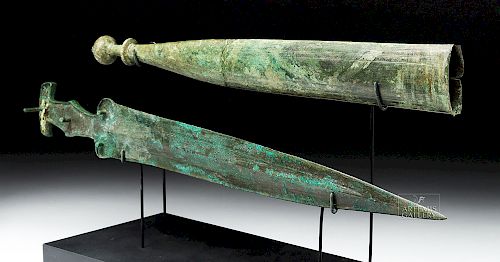Important Etruscan Bronze Sword & Sheath - Ex Guttman
Lot 72
About Seller
Artemis Fine Arts
686 S Taylor Ave, Ste 106
Louisville, CO 80027
United States
Selling antiquities, ancient and ethnographic art online since 1993, Artemis Gallery specializes in Classical Antiquities (Egyptian, Greek, Roman, Near Eastern), Asian, Pre-Columbian, African / Tribal / Oceanographic art. Our extensive inventory includes pottery, stone, metal, wood, glass and textil...Read more
Categories
Estimate:
$14,000 - $18,000
Absentee vs Live bid
Two ways to bid:
- Leave a max absentee bid and the platform will bid on your behalf up to your maximum bid during the live auction.
- Bid live during the auction and your bids will be submitted real-time to the auctioneer.
Bid Increments
| Price | Bid Increment |
|---|---|
| $0 | $25 |
| $300 | $50 |
| $1,000 | $100 |
| $2,000 | $250 |
| $5,000 | $500 |
| $10,000 | $1,000 |
| $20,000 | $2,500 |
| $50,000 | $5,000 |
| $100,000 | $10,000 |
| $200,000 | $20,000 |
About Auction
By Artemis Fine Arts
May 10, 2018
Set Reminder
2018-05-10 10:00:00
2018-05-10 10:00:00
America/New_York
Bidsquare
Bidsquare : Fine Ethnographic / Asian / Ancient Art
https://www.bidsquare.com/auctions/artemis-gallery/fine-ethnographic-asian-ancient-art-3213
Featuring antiquities from around the world including Pre-Columbian, Tribal, Classical, Asian, so much more! Artemis Fine Arts info@artemisgallery.com
Featuring antiquities from around the world including Pre-Columbian, Tribal, Classical, Asian, so much more! Artemis Fine Arts info@artemisgallery.com
- Lot Description
Classical World, Etruria, late Bronze Age to early Iron Age, ca. 900 to 700 BCE. An incredibly rare, well-preserved cast bronze sword with a decorated blade and a fitted sheath. The sword has a short, sharply pointed blade, with a flanged hilt and a square-edged crescent pommel (also known as a T-shape sword). Below the pommel, the hilt has a gentle diamond shape that then widens into a guard just above the integral, triangular blade. Four rivets remain for attaching some material to the handle - ivory, bone, amber, etc. that would have looked beautiful in contrast with the bronze. The blade has a raised, triangular ridge, and, just barely visible through the turquoise patina, decorative incised geometric lines down the sides of the ridge. Size of sword: 1.95" W x 17.5" H (5 cm x 44.4 cm); size of sheath: 2.15" W x 14.4" H (5.5 cm x 36.6 cm); 8.7" H (22.1 cm) on included custom stand.
This sword is of the type known as Pontecagnano, after an Etruscan cemetery found in the modern day small town of the same name, located south of Naples in Campania. However, swords of similar type have been found throughout the Etruscan world, including in the famous Etruscan cemetery at Tarquinia and also in Vulci. The sheath is made of bronze sheet, with a paler green patina, a triangular form, and a globular terminal below a disc. Low relief, thin lines flow down the sheath to reach a point just above the disc.
During the early Iron Age, the Etruscans adopted the "Italic" style of T-shaped swords, some of which even had figural scenes, telling stories about hunting, incised on their faces. Some researchers have theorized that all of these swords originated at a particular workshop located in Pontecagnano itself. We know of them from Etruscan graves, where most people were cremated and buried in pit tombs alongside swords and daggers. Fascinatingly, during this time period, there seems to have been an egalitarian ideology, with most graves having the same level of rich grave goods.
See a similar example at the National Archaeological Museum of Florence (Italy), found in Tomb 1 at Tarquinia, and another at the British Museum: http://www.britishmuseum.org/research/collection_online/collection_object_details.aspx?objectId=400575&partId=1
Provenance: ex private Cyrpus, Texas, USA collection, acquired at Royal Athena Gallery, New York, USA, Ex Axel guttman collection, Germany, acquired in the 1980s
All items legal to buy/sell under U.S. Statute covering cultural patrimony Code 2600, CHAPTER 14, and are guaranteed to be as described or your money back.
A Certificate of Authenticity will accompany all winning bids.
We ship worldwide and handle all shipping in-house for your convenience.
#132717Sheath has been repaired approximately one-third of the way up from its tip. Losses near the top of the sheath - it probably had a guard made of some other material that has worn off. The blade has slight bending to form near the guard/handle. The handle material is lost, with the flanged hilt still present. Some remains of handle material still present in the upper part of the handle. Mottled green patina on both, with more of a turquoise color on the blade itself.Condition
- Shipping Info
-
All shipping is handled in-house for your convenience. Your invoice from Artemis Gallery will include shipping calculation instructions. If in doubt, please inquire BEFORE bidding for estimated shipping costs for individual items.
-
- Buyer's Premium



 EUR
EUR CAD
CAD AUD
AUD GBP
GBP MXN
MXN HKD
HKD CNY
CNY MYR
MYR SEK
SEK SGD
SGD CHF
CHF THB
THB














